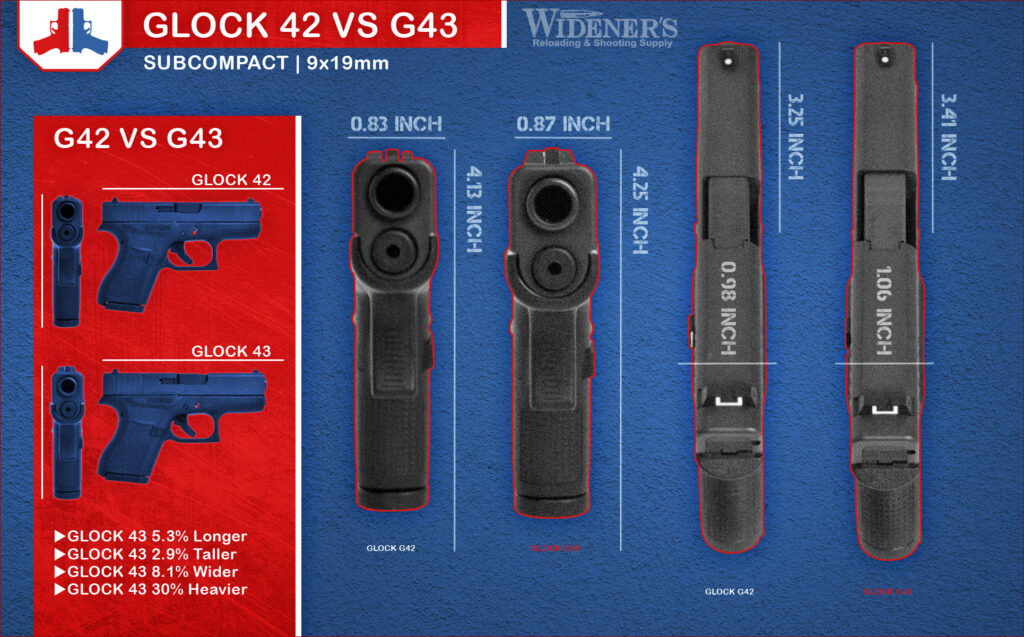
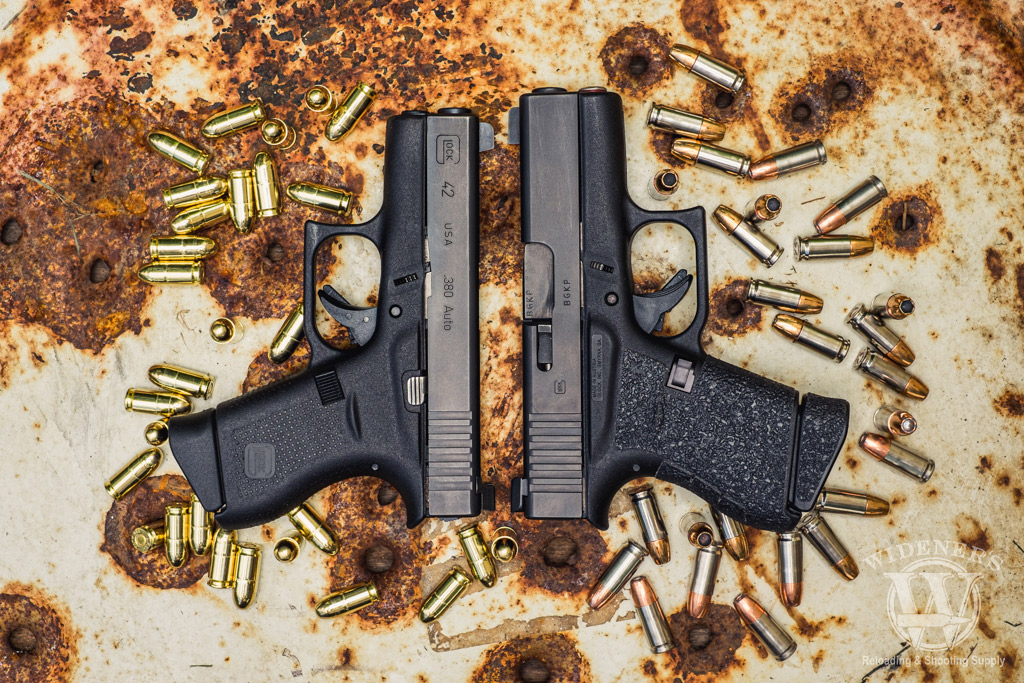
Author: Jacob Long
Choosing the right concealed-carry gun can be a time-consuming task. There’s no shortage of sub-compact pistol options on the market. Every manufacturer seems to make them, but Glock remains one of the most popular options. Even within Glock’s own lineup, you have options like the Glock 42 VS 43. Glock’s reliability and reputation for quality keep consumers coming back for more.
Since their introduction, the Glock 42 & 43 have proven to be quality subcompact guns with competitive pricing. While some Glock owners prefer one model over the other, many own both. The size benefits of sub-compact pistols may seem obvious, but what are the drawbacks? With so many options in the same category available, how do you decide which gun is right for you?
For a better understanding of the similarities and differences, we’ll compare the .380 ACP Glock 42 VS 43 chambered in 9mm. How do this two sub-compact, single-stack options match up against each other? Let’s take a look below.
Glock 42 VS 43: Side By Side Comparison
The Glock 42 hit the market first, the G43 followed and achieved the same commercial success as its little brother. Following the success of the Glock 43, Glock has expanded its single-stack series to include the G43X and G48. This sub-compact series focuses on reduced size and weight with improved concealed carry ergonomics and performance.
| Glock 42 | Specs | Glock 43 | Specs |
|---|---|---|---|
| Caliber | .380 ACP | Caliber | 9x19mm |
| Barrel Length | 3.25″ | Barrel Length | 3.41″ |
| Overall Length | 5.94″ | Overall Length | 6.26″ |
| Slide Length | 5.75″ | Slide Length | 6.06″ |
| Width Overall | 0.98″ | Width Overall | 1.06″ |
| Height W/ Mag | 4.13″ | Height W/ Mag | 4.25″ |
| Avg Weight Loaded | 16 oz / 1 lbs | Avg Weight Loaded | 20.64 oz / 1.29 lbs |
| Avg Trigger Pull | 5.5 lbs | Avg Trigger Pull | 5.5 lbs |
| Capacity | 6+1 | Capacity | 6+1 |
| Sights | White Dot/GNS/Ameriglo | Sights | White Dot/GNS/Ameriglo |
| Finish | Black nDLC | Finish | Black nDLC |
| MSRP | $429 | MSRP | $529 |
The first thing you’ll notice about the Glock 42 VS 43 is the size difference. Looking at the two pistols side by side, they have comparable dimensions, except the G43 is slightly wider (G43 1.06″ vs. G42 0.98″ Wide) and taller (G43 4.25″ vs. G42 4.13″ Tall) with magazines in place. The G43 is also a bit longer, although, it’s not immediately noticeable until you place both pistols side-by-side (G43 6.26″ vs. G42 5.94″ Length).
Unfortunately, neither pistol features a factory accessory rail. It’s possible the exclusion was a design choice by Glock to keep the overall size as compact as possible. The G42 has a compact size advantage, although the G43 isn’t much bigger. However, depending on your attire when carrying concealed, a little can be a lot.
Can you use your G43 magazines in your G42, or vice-versa? Nope. Although likely for safety reasons, the G42 magazines are only compatible with the G42. Sadly, the G43 magazines are also only compatible with the G43. Glock didn’t see a reason for the slimline sub-compact pistol series (G42, G43, G43X, G48) to have magazine compatibility across the board.
G42 VS G43 Weight Comparison
The Glock 43 is 30% heavier (G43 20.64 oz/1.29 lbs vs. G42 16 oz/1 lbs) than the G42 when loaded with comparable ammo. Part of this extra weight is the additional slide length of the G43. Both guns feel well-balanced in hand, neither feels top-heavy as some sub-compact competitor pistols tend to do. The weight advantage goes to the Glock 42.
The G43 features a 3.41″ barrel, the G42 has a 3.25″ barrel. Both are factory standard Glock Marksman Barrels (GMB). The Glock 43 barrel weighs 2.6 oz and is 1.9mm thick. The Glock 42 barrel weighs 1.9 oz and is 1.5mm thick. Both the G42 and G43 are very accurate from a bench rest at twenty-five yards.
I tested the accuracy of both guns by firing at IDPA cardboard targets from the bench, with Fiocchi FMJ ammunition. Using four different targets I fired two rounds of five shots from each gun. I averaged 6″ groups with the G43 and 6.3″ groups with the G42. At a distance of twenty-five yards, those differences are negligible. It’s my opinion that both pistols are well-matched and perform according to Glock’s listed specifications.
Pistol Widths Compared
The overall width of the G43 is slightly wider than the G42 (G43 1.06″ vs. G42 0.98″). Looking at both pistols side-by-side, the difference in width is noticeable. I did find that despite the difference, the G42 fit snugly into several G43 holsters. The only noticeable gap in the holsters was at the bottom, due to the difference in barrel length.
Both guns feature rear frame beavertail, textured grips and a large textured magazine release. The G43 has a slightly thicker grip (G43 0.95″ vs. G42 0.85″) allowing for increased stability in-hand. The trigger distance of the G43 is greater than the G42 (G43 2.56″ vs. G42 2.4″). In my large hands, that made finding the G43 trigger easier, since there’s more room to move your finger from resting position on the slide of the gun.
Glock 42 and 43 Ergonomics Compared
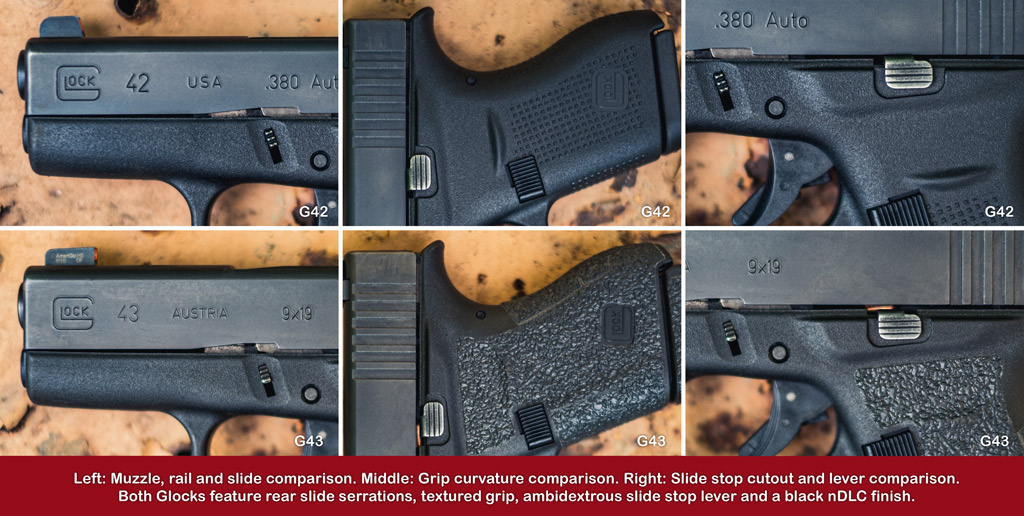
The ergonomics of both sub-compact pistols have some compromises, you can only fit so much in a small package. It should be noted the Glock 43 in this comparison features an aftermarket grip cover made by Talon Grips.
The grip length of both pistols feels diminutive in size without a magazine inserted. With the standard flat factory magazine installed, my pinkie finger ended up below the magazine on both guns. I had to use the factory magazine with the pinkie extension on both guns to make holding them comfortable while shooting. If you have small to medium-sized hands, you may find the shorter gips to be more comfortable.
On larger sub-compact guns like the G48 or G43X, the grips are more balanced. In comparison, the grips of the G42 & G43 almost feel too short to maintain a good purchase. Cycling a few magazines through both guns requires constant adjustment of my hand on the grips. Unfortunately, at the time of writing this, there aren’t any factory backstrap options for either gun to improve the grip.
Getting Triggered?
If you’ve shot any of the single-stack Glocks, you already know what I’m about to bring up. The ‘squishy’ factory trigger on these guns does not inspire feelings of confidence. There’s a fair amount of takeup and the break is all the way to the rear of the mechanical action. Putting both guns on a digital trigger pull gauge, I completed three trigger pulls for each and got an average of around 5.5 lbs.
Ammo Capacity: Brothers In Small Arms
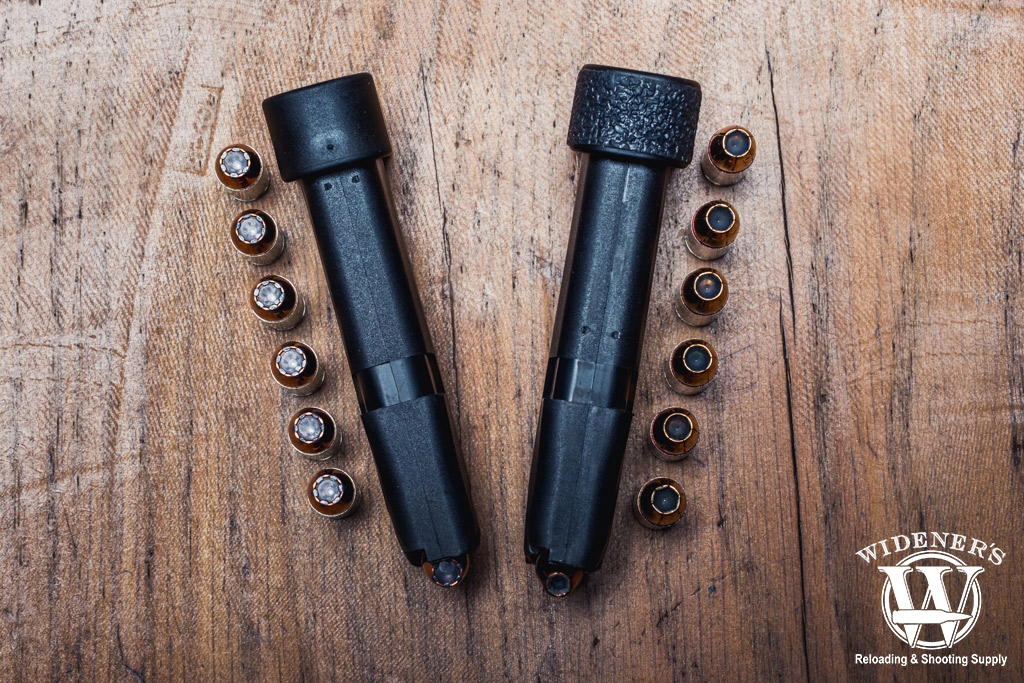
It’s important to know your limitations, especially when it comes to ammo capacity.
Are six-rounds really enough? It’s a fair question. Six-rounds provides one round more than the capacity of most standard revolvers. Being able to carry an additional round in the chamber to make seven is nice, but is it enough? Critics of carrying single-stack pistols for self-defense often point to the limits of the six-round magazines. With higher capacity options like the G43x & G48 (10+1) available, are the older G42 and G43 models obsolete?
Not quite. Aftermarket manufacturers offer +1, +2, and +3 magazine base pads for the Glock 42 & 43. With a +3 machined aluminum base pad installed, either gun becomes a 9+1 capacity pistol, narrowing the advantage of the modern single-stack Glocks. Adding magazine extensions does increase the size and weight of both pistols, but it also makes them more competitive. As with any aftermarket accessory, make sure to thoroughly test your weapon once it is installed to ensure that it is functioning correctly.
Recoil Compared
The G42 handles recoil better than the G43. Although I don’t have a scientific way to explain it, I do have a comprehensive explanation. The G42 weighs about 1 Lbs when loaded, the most common self-defense .380 ACP bullet weight is 90gr. The average velocity of the 90gr bullet leaving the 3.25″ barrel of the G42 is 976 FPS. That gives the G42 with a 90gr .380 ACP bullet a muzzle energy of 190 foot Lbs.
The G43 weighs about 1.29 Lbs when loaded, the most common self-defense 9mm bullet weight is 124gr. The average velocity of the 124gr bullet leaving the 3.41″ barrel of the G43 is 1168 FPS. That gives the G43 with a 124gr 9mm bullet a muzzle energy of 376 foot Lbs. That’s a difference of 186 foot Lbs, which means the Glock 43 has almost double the muzzle energy of the G42.
Given that explanation, it makes sense why the Glock 43 feels ‘snappier’ than the G42. Followup shots with the G42 come easier and feel more natural when squeezing the trigger in rapid succession. The advantage goes to the G42 for recoil management.
Glock 42 VS 43: Ballistics Testing
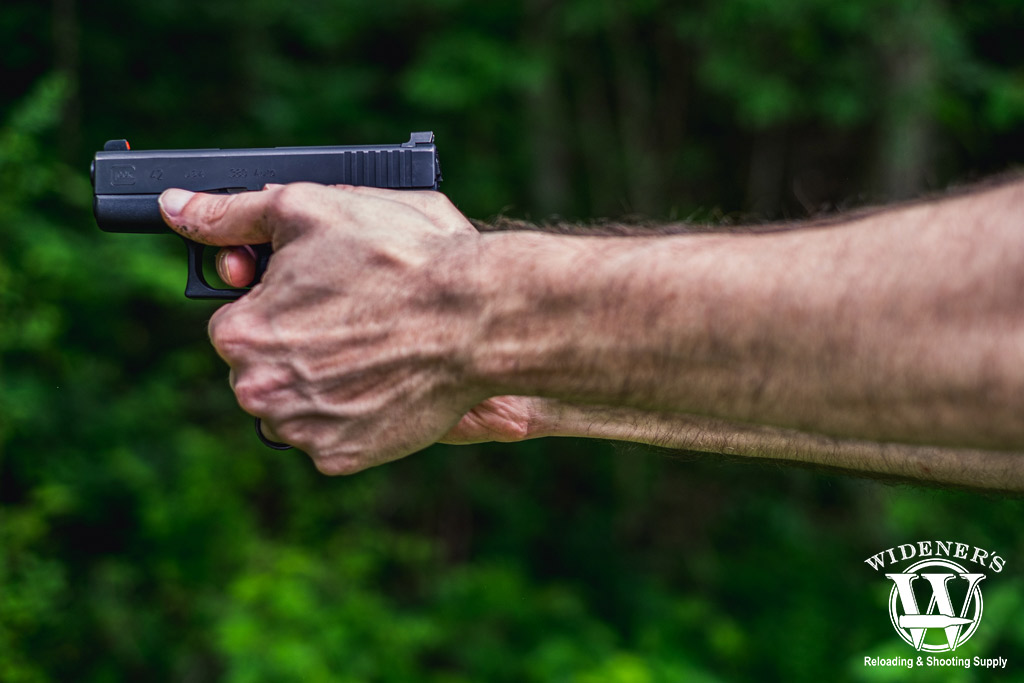
Glock 42 VS 43: The ballistics of both pistols were tested with popular self-defense ammo at the range.
I used a ballistic chronograph at the range to test popular self-defense ammo for both calibers. I shot ten rounds of Speer Gold Dot 9mm JHP 124gr +P, and Federal HST 9mm JHP 147gr with the G43. Ten rounds of Speer Gold Dot .380 ACP JHP 90gr, and Federal HST .380 ACP JHP 99gr were also tested with the G42.
The data captured from the chronograph was recorded at a distance recommended by the chronograph manufacturer. It was recorded using a calibrated unit set to capture pistol ballistics. The mechanical function and accuracy of both pistols was excellent, I had no issues with feeding, firing, or ejecting.
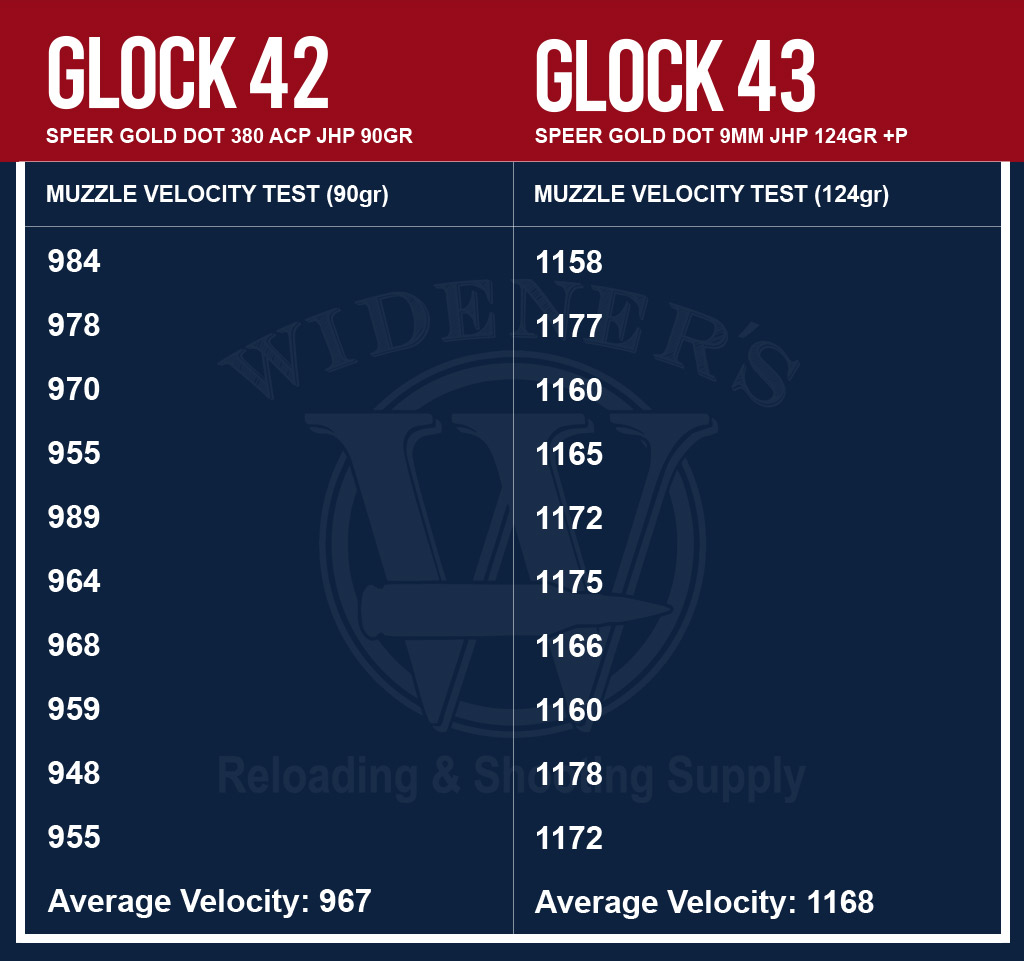
Speer Gold Dot 9mm JHP 124gr +P ammo is a high-pressure cartridge designed for self-defense.
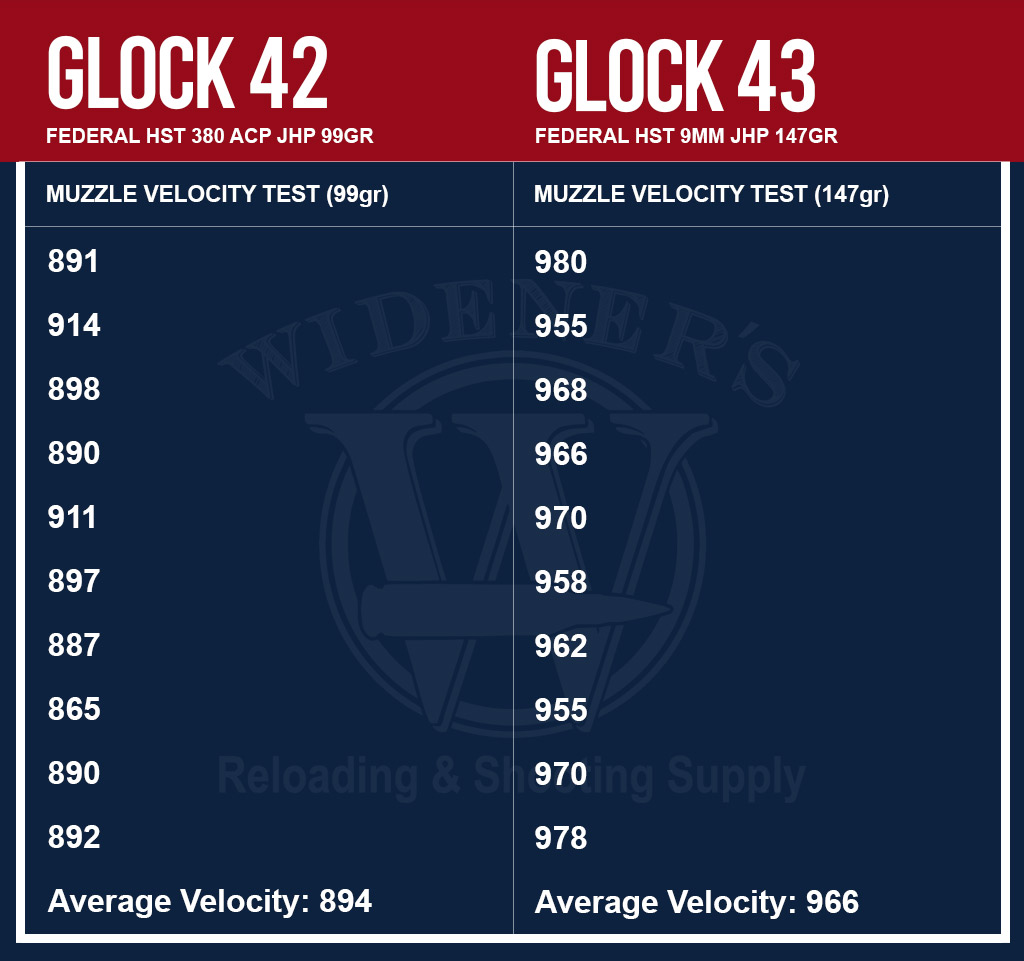
A heavy grain weight ammo, like Federal HST 9mm JHP 147gr, leaves the barrel at lower velocities.
The G43, loaded with Speer Gold Dot 9mm JHP 124gr +P pushed an average velocity of 1168. The G42, loaded with Speer Gold Dot .380 ACP JHP 90gr had an average velocity of 967. With Federal HST 9mm JHP 147gr loaded, the G43 had an average velocity of 966. The G42 loaded with Federal HST .380 ACP JHP 99gr had an average velocity of 894. Given the length of the gun barrels, these velocities seem to be in line with the ammunition manufacturer’s specifications.
Ballistic Gel Comparisons
For the ballistic gel comparison, I set up two gel blocks and covered the end facing the muzzle of the gun with layers of fabric, per the FBI test protocol. Four types of ammunition were tested, and five rounds of each were fired into the gel blocks from the corresponding handguns. The gel blocks were changed out every five rounds between the four different ammunition types. The penetration depth of each round was measured and afterward, the rounds were removed from the blocks and documented. See the test results below.
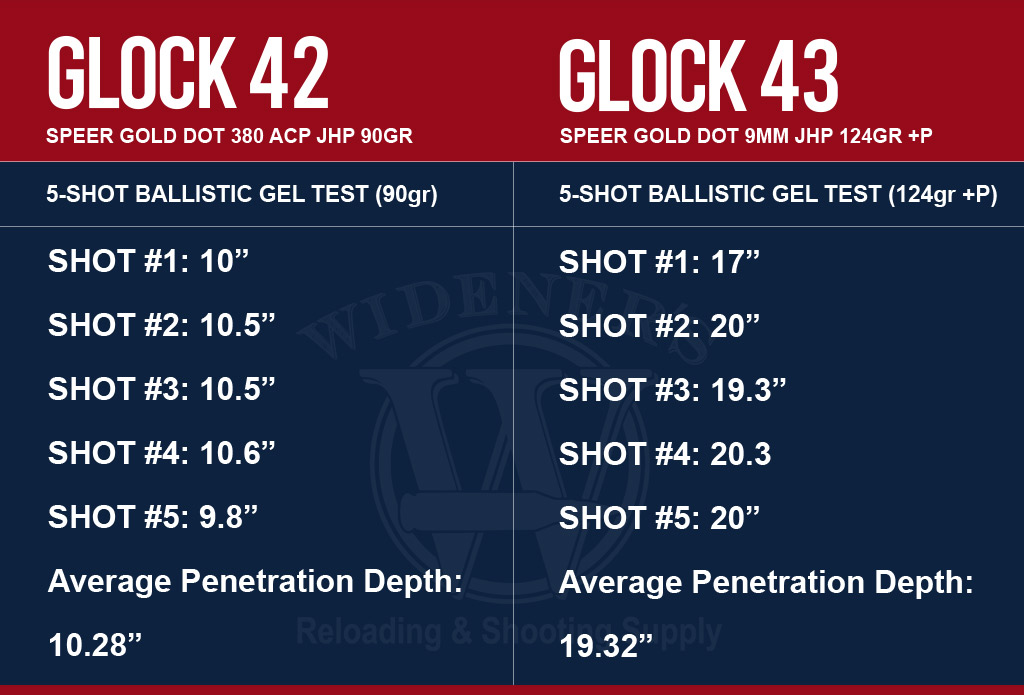
In our test, the 9mm Speer Gold Dot ammo penetrated to an average depth that was almost twice the distance of the .380 rounds.
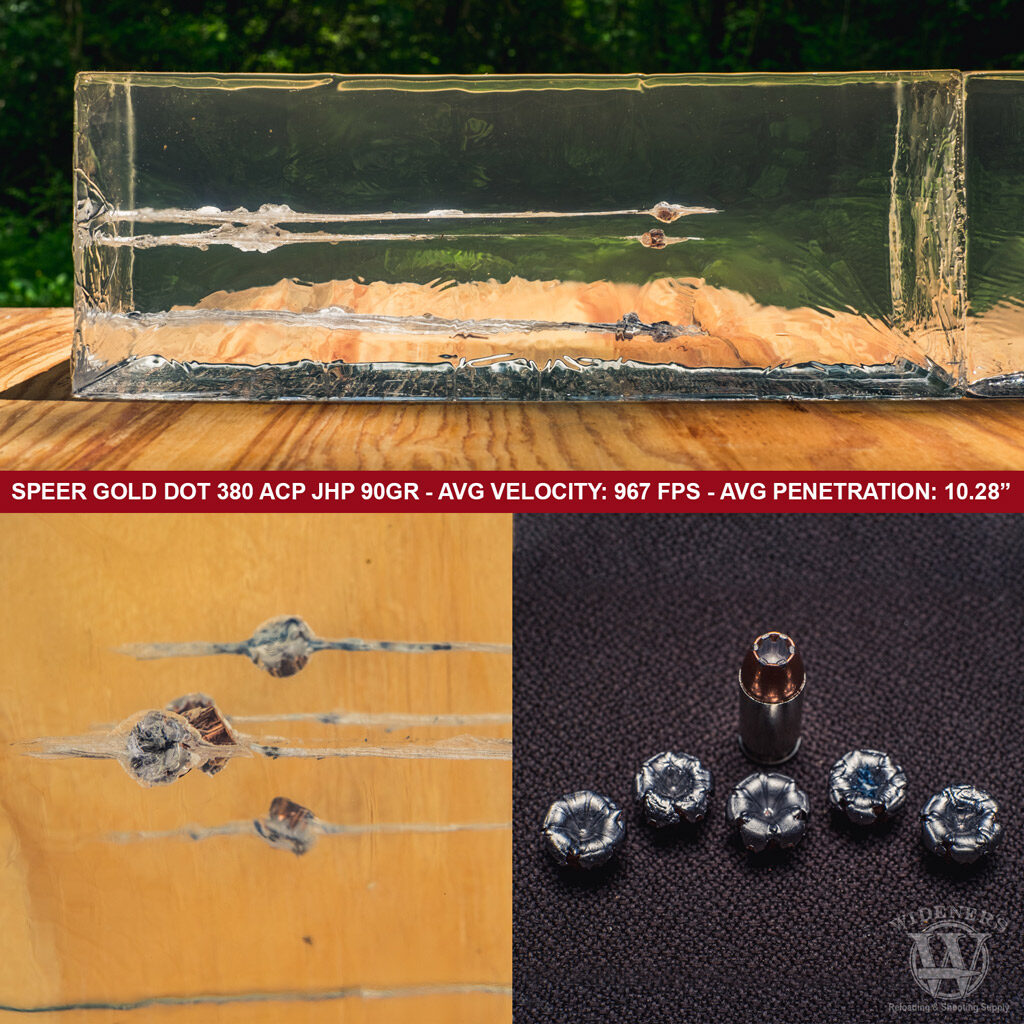
All five rounds of the Speer Gold Dot .380 ACP JHP 90gr ammo achieved full expansion in our testing.
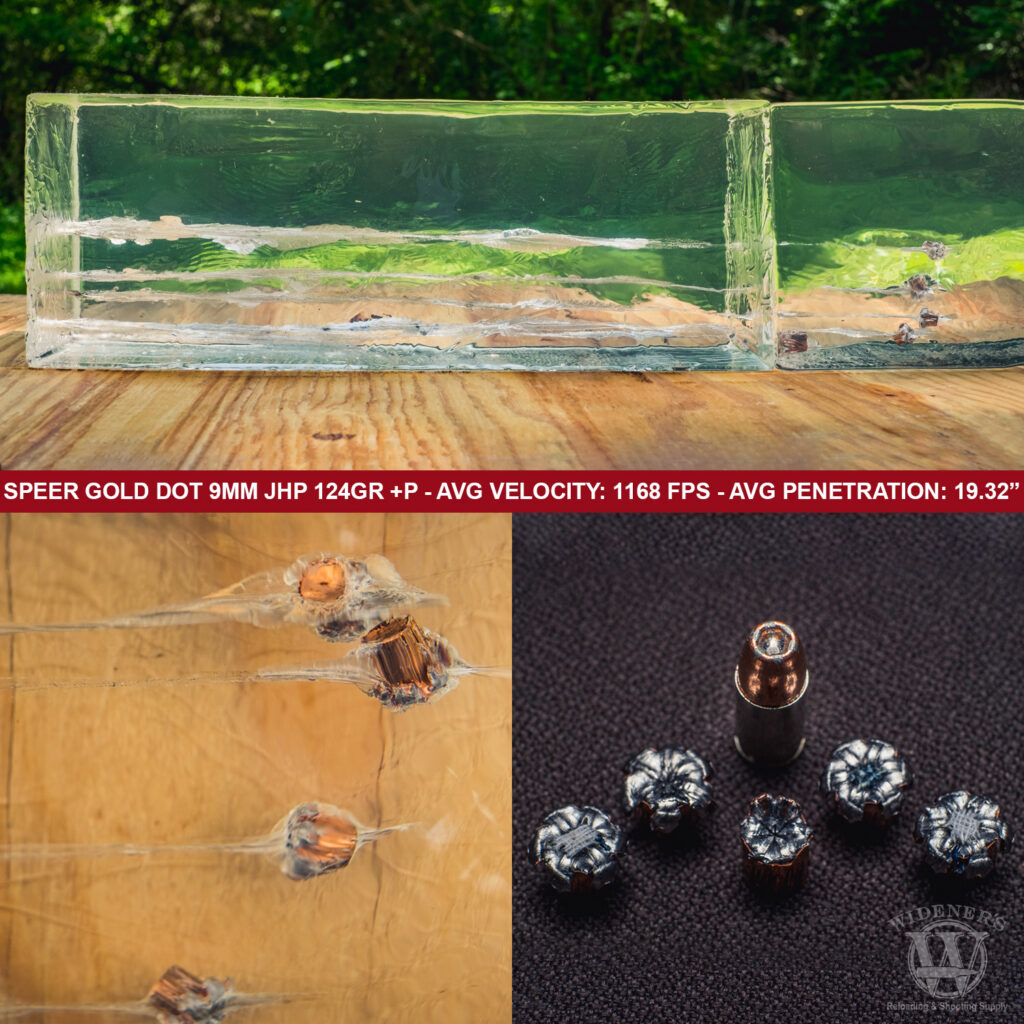
Four of the five Speer Gold Dot 9mm JHP 124gr +P rounds we tested achieved full expansion. The round that didn’t fully expand was Shot #1 which came in contact with the plywood surface the gel blocks were sitting on.
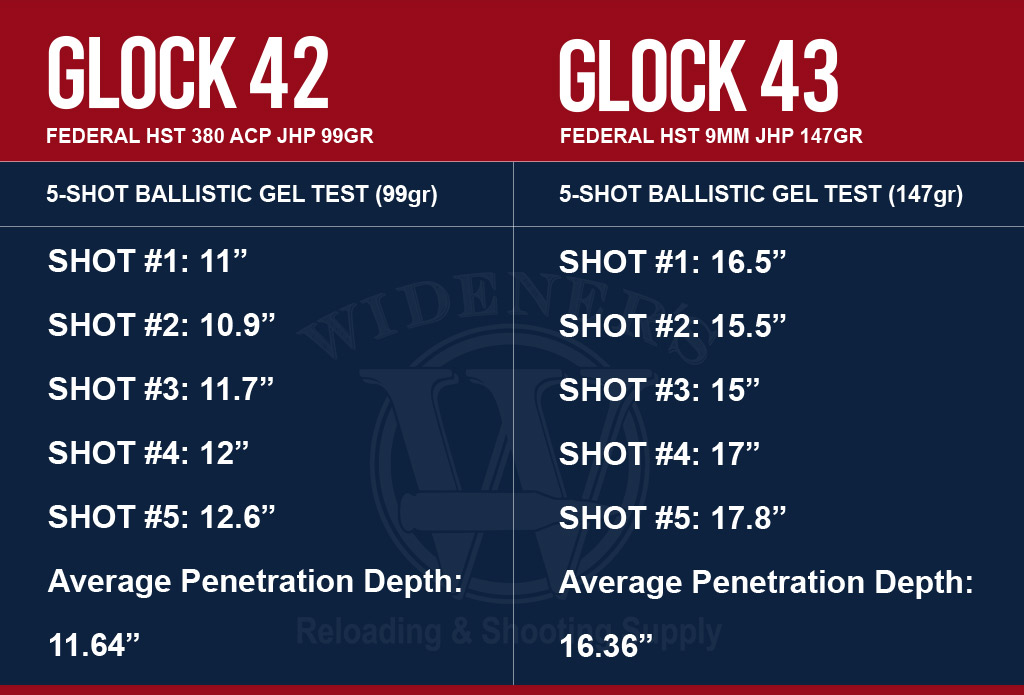
In our test, the Federal HST .380 ACP JHP 99gr ammo came close, but didn’t end up with an average penetration depth that met the minimum FBI required standard of 12″ for duty ammo.
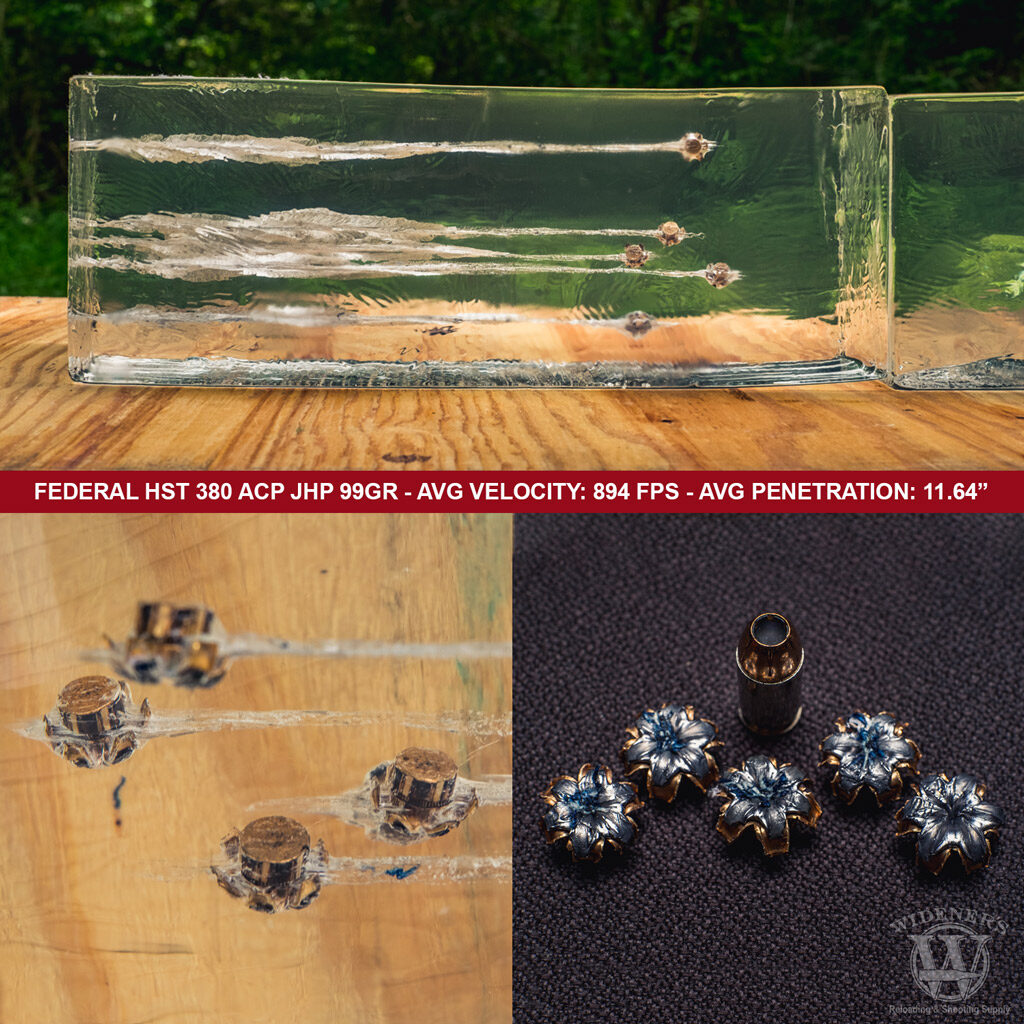
All five rounds of the Federal HST .380 ACP JHP 99gr ammo achieved full expansion in our testing.
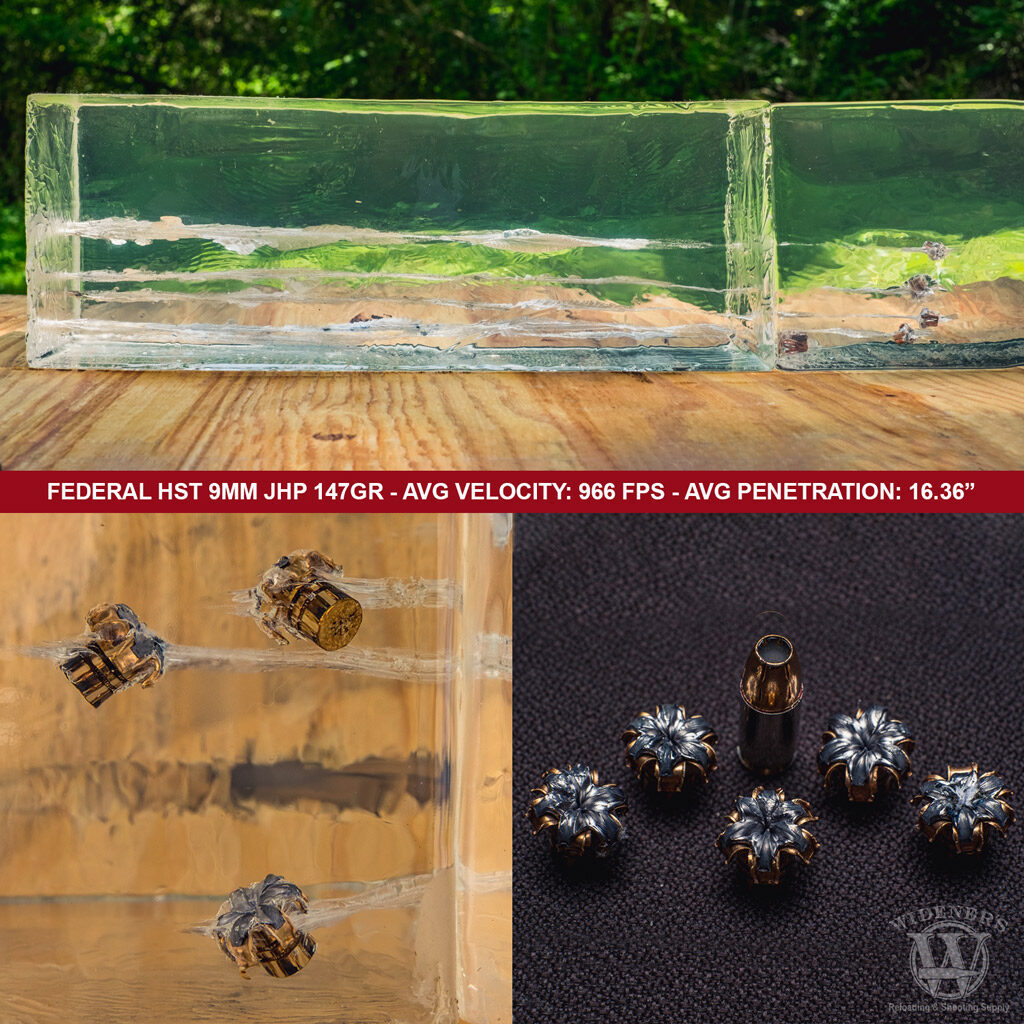
All five rounds of the Federal HST 9mm JHP 147gr ammo achieved full expansion in our testing.
The FBI protocol requires duty ammunition to penetrate between 12″ and 18″ in ballistic gelatin. From our testing, we can see that both the Speer Gold Dot 9mm JHP 124gr +P and Federal HST 9mm JHP 147gr ammo fired from the G43 met, or exceeded these requirements. However, the .380 ACP ammo fired from the G42 did not. The ballistic advantage goes to the G43.
Glock 42 VS 43: Best for Concealed Carry?
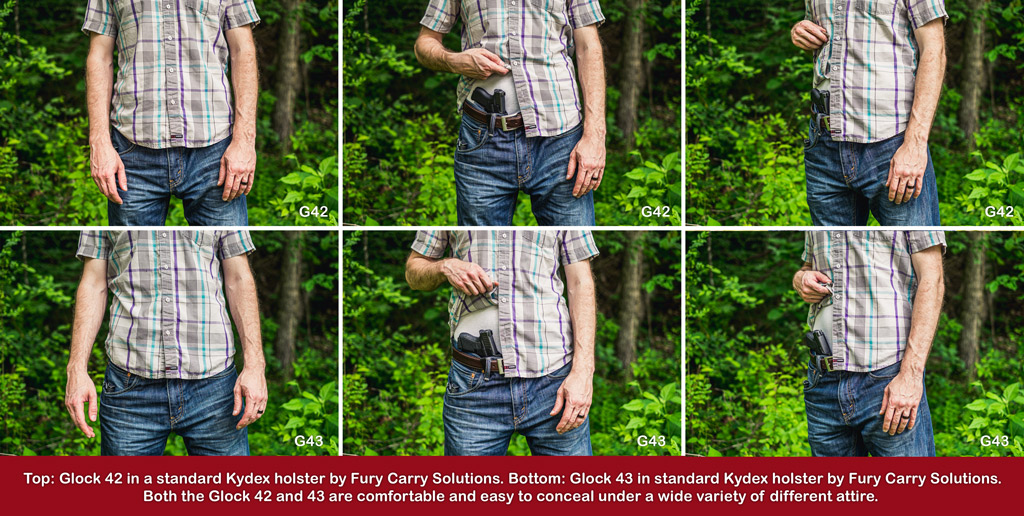
Sub-compact sized pistols like the G42 and 43 are easy to conceal under a wide variety of attire.
I carried both pistols for a week, swapping them out on different days. Both pistols were carried appendix IWB, with a full magazine, in condition one. When swapping from the G42 to the G43, the difference in weight was noticeable, the difference in size was not. This could also be due to the fact that the holsters used are relatively the same size. Both pistols are easy to conceal, or deep conceal, depending on your needs.
Drawing From A Holster
Drawing and reholstering a subcompact pistol is a skill that requires a fair amount of practice. I had no trouble drawing, or reholstering either gun from a standard Kydex holster in the appendix position. I did however have some issues with getting a good purchase on the guns during the draw stroke. Getting a good purchase on a smaller grip requires more focus and precision. If you plan on purchasing one of these sub-compact options, you’ll want to safely practice your draw stroke until you can do it with confidence.
Comfort Of Carry
Carrying the sub-compact Glock 42 or G43 is very comfortable. The single stack Glocks are slim and lightweight in comparison to a standard size pistol. I had no wardrobe printing issues with either pistol using a standard Kydex holster in the appendix position. Pocket carry with a slim holster is possible with both pistols. However, I found the additional size and weight of the G43 to be a disadvantage for that purpose.
Glock 42 VS 43: Which Gun Should You Buy?
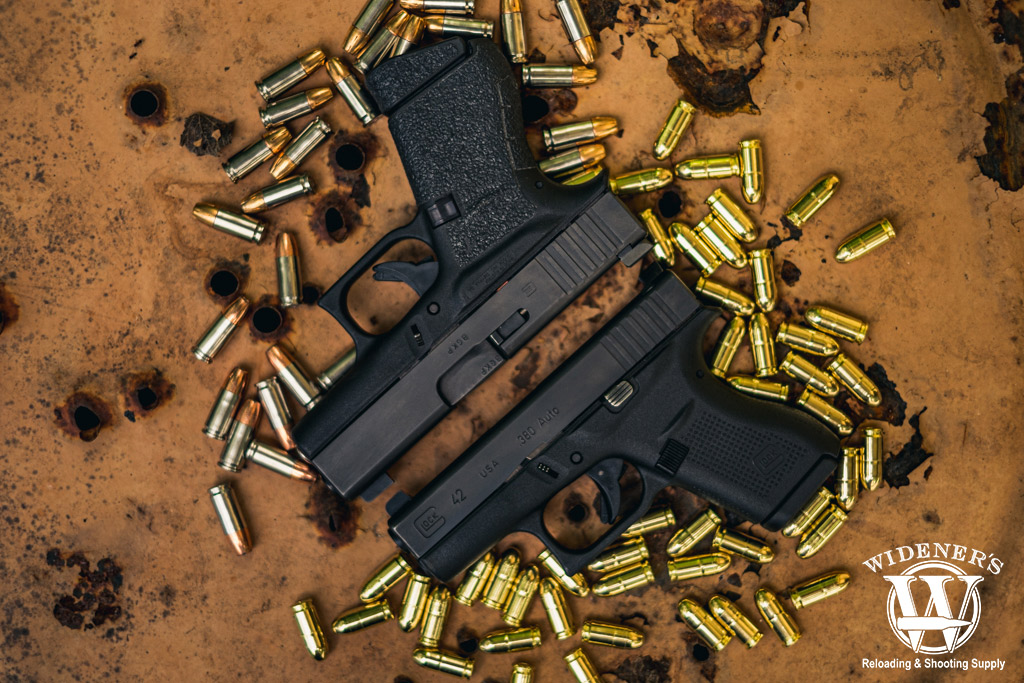
Consider your primary needs when selecting a sub-compact handgun. How important are size, weight, and capacity to your objectives?
Subcompact pistols with short barrels have physical limitations. If you decide to purchase and carry one for self-defense, you’ll need to train with it on a regular basis. Be realistic with your expectations, train to hit targets at distances suitable to your capabilities. Learn the weapon’s limitations, work to minimize them, and train until you feel comfortable with using it.
If size, weight, and concealment are your top priorities, the Glock 42 is your best option. It may not have the ballistic performance of the G43, but it’s reliable and comfortable to wear concealed. You can add an aftermarket magazine base plate to increase the capacity of both pistols, however, you also lose the weight and size advantages.
The G43 has a lot to offer as well. It shares caliber compatibility with full-size or compact 9mm Glock pistols, like the G17, and G19. Ballistic data tells us a lot about the performance of popular self-defense loads fired from the G43. They meet or exceed FBI duty standards in the pistol with consistent results. On average, the price of 9mm ammo is cheaper than comparable .380 ACP ammo. The G43 may have more “snap” than the G42, but as a consumer, you’re also getting more bang for your buck.



